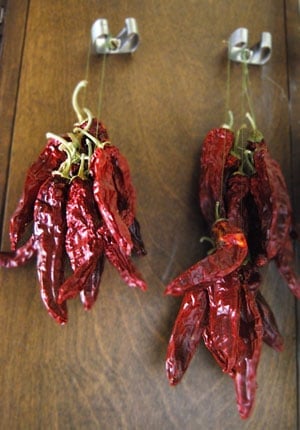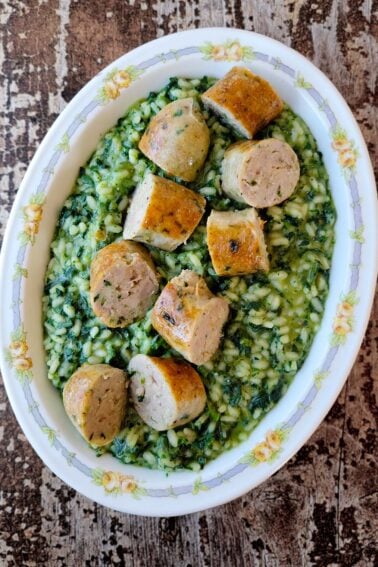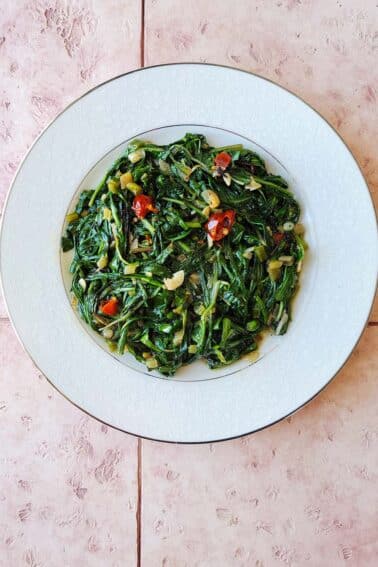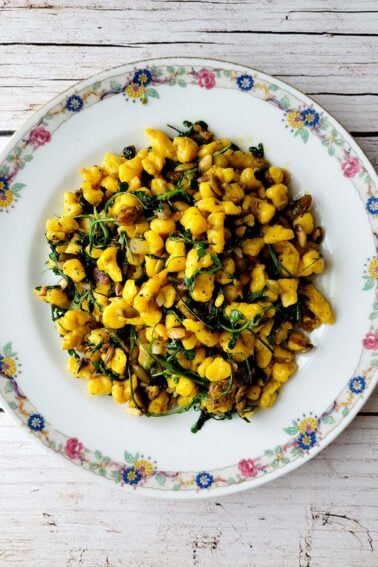As an Amazon Associate I earn from qualifying purchases.

Why bother making homemade paprika? Fair question. After all, the Spanish and Hungarians are better at it than we ever will be, right?
Why not just call up Penzey’s or somesuch and order some? Well, I do. But making something like paprika at home is not so much something I did out of necessity as it was an exercise in whether I could do it at all.
It’s not that I think the world is about to collapse and oh-where-oh-where will I get the paprika to make my chorizo or chili or goulash, not to mention deviled eggs? It’s that I have a fascination with how things are made; I am a sucker for those shows on Discovery Channel or NatGeo.
So I asked myself: “What would it take to make enough paprika for our household use for one year?” And just how do you make paprika?
Turns out making paprika is easy, but it takes a while. You basically need to start paprika long before you want the powder by growing the right kind of peppers. Almas or boldog peppers are standard: They’re vivid red peppers that aren’t too thick; bell peppers are not ideal. Why? Thick-walled peppers tend to rot when left to dry, although you can certainly use a dehydrator to prevent rot if all you have are ye olde bell peppers.
The reason paprika peppers are so special is because they have character. They are neither too sweet or too spicy. No matter what pepper you use, you want something in between. I find that poblanos, left to fully ripen, are another excellent substitute, but very different.
Here is a primer on all things paprika, if you want to go down that rabbit hole.
For my paprika experiment, I planted three Alma Paprika Pepper plants, and at the end of the season I had several strings of peppers hanging in our garage.

This first thing about making paprika I learned as I broke them into smaller bits to grind was this: Chiles need to be dried in arid, hot shade. Drying in the sun bleaches away color. Excess heat, like you’d get in an oven, adds an almost cooked aroma to the chiles.
And in all cases, humidity is the enemy. I dried a couple peppers in the (more humid, cooler) house and when I opened them up they were all fuzzy inside. Mold. I tossed them. None of the peppers in the garage had mold. (I live in Sacramento, California, where it is very hot and dry in the summer.)
Making the powder is pretty easy. Break the peppers into pieces small enough to jam into a spice grinder. I discard the seeds, because including seeds dilutes color and can increase the heat if you’re using hotter chiles. The grinding takes a few steps, because you always get a a few pieces that don’t want to grind. Keep sifting the bits through a fine-mesh sieve until you get an even powder.
That’s all there is to it.
In that first experiment, I wound up with 10 tablespoons of paprika from the peppers you see hanging in the picture. Definitely not enough for a year, but maybe for a few months — unless I wanted to make a huge batch of chorizo or Italian hot sausage. Given all this, I reckon I’d need 10 to 15 plants to supply me for a year.
The cool thing about this experiment is that 10 to 15 plants is actually a reasonable number in my garden, if I so chose to devote that much space to paprika. And since I am decent enough at growing chiles from seed, I could have a perpetual supply for nothing.
What’s more, my homemade paprika tastes just as good or better than the expensive kind I buy from Penzey’s. That was something of a surprise — and confirmation that there is no great mystery to making this spice. (Spanish smoked paprika is quite another thing.)
But still. Was it all worth it? The planting and the hanging and the months’ worth of waiting? Sure, if you have space and time. Grinding your own paprika is satisfying, and you get some really, really good spice out of it.




I live in an apartment in cold Canada so am not able to grow the peppers and I haven’t seen that kind of pepper in the grocery store but, despite that, I would love to try making my own paprika. I make my own garlic and onion powder and it is so good that my son, who is an amazing chef, doesn’t buy fresh garlic anymore. He uses my homemade garlic and onion powder. I don’t buy Asian; I buy organic or Canadian grown garlic only so it costs more. I make jalapeño powder and celery powder. I have a top-of-the-line dehydrator. I give as gifts and people love them. Thanks for this.
I grew Alma paprika from seed which came from a local herb farm. My peppers looked quite different than the ones in your picture. Mine are small, round with very thick flesh. I understand from my Hungarian friend that they use these ones for making stuffed peppers as well as paprika. Sadly my 2 plants only yielded 6 peppers but I’m hoping to keep the seed for next year and try again.
I am trying this year to grow my own NuMex R. Naky peppers which are an Anaheim. Using it for paprika mainly to make no sodium chili powder. I will smoke some too. I’m hoping 6 plants will grow enough for a year. I just have to keep the wife from using peppers to make chili relleno. I bought “R. Naky” seeds on Amazon last year and after they all began to grow, they were not an Anaheim but a cayenne. I did not waste these peppers and made an awesome hot sauce. I need to grow these as well for I am now hooked on this.
I’ve been making paprika for a year now and I grow red bells and Hungarian cherry peppers. After harvest, I smoke the cherry peppers and then together with the red bells, I freeze dry them. Once freeze dried, I grind in my VitaMix which give a really fine powder and then store. I took some to a friend of mine in Eastern Europe and she loved it.
My wife and I grow and make our own paprika. I smoke some and others we dry in a dehydrator. The scent, taste, and flavor beats anything you get from a grocery store. We also grow jalapenos, serrano, and colored bell peppers. We do 10 to 12 paprika plants each year. The wife blends 2 or 3 of each for a spicy pepper blend.
Hi Hank,
I did a similar experiment making paprika using paprika peppers. Do you recall if your paprika smelled like peppers versus actually smelling like the paprika you buy?
I, too, live in Sacramento County.
Thanks,
sandy
I grow Leutschauer peppers for my paprika. This is our 3d year doing it. we have dehydrated and smoked and air dried the peppers to use various methods and achieve various tastes. I love this paprika. Leutschauer peppers make the very best paprika and is used throughout most of the paprika producing world. The best paprika! I save the seeds. We ahem not needed to buy seeds for years or buy paprika. I intend to the the Paprika Baron of the US. YaY!
I’m glad I found your article, it confirmed my proposed grinding plans.
I planted two Boldog plants.
I thought they might yield at the same rate as my Hungarian half-hot yellow wax peppers.
No luck, I get 20 peppers off each of my 12 yellow guys but only lime 5 off the Boldog.
Enough to play with and see how I like it.
I get my paprika direct from Hungary as we visit every other year to see family.
I have the ultimate benchmark to compare with my own production.
Has anyone used guernica peppers for making chorizos?
I planted heirloom Leutschauer paprika peppers I ordered from a seed catalog. Do you know anything about them? I plan on keeping the seeds for future plants.
I’ve grown the Leutschauer peppers for years and make paprika. It’s a staple in my garden, along with black Hungarian paprika peppers.
I am growing the Leutschauer and Ostra Cyklon Paprika peppers for the 1st time as well. I only transplanted two plants of each from my own seed starts. I planted them each in 20 gal. growbags. I just picked some of the “Leuts” but am waiting for the rest to mature before I dehydrate and grind them into a powder. I plan to remove all the seeds before I grind for paprika. I will probably grow a lot more next year because I didn’t get the yield I was hoping (my issue is not the seeds). Same deal with the Ostra. I will keep the two varieties separate to see which I like better. So right now, I can’t answer your question, but I’ve not seen anything negative about them. The Ostra seeds are imported from Poland. Chances are that the “Leuts” are imported from Hungary. My seeds were sold by Baker Creek. Take care … hope you are having a great harvest.
Thanks so much! I will definitely try this. I’m allergic to bell peppers and have had a reaction to a lot of the Paprikas on the market. I grow peppers in pots and usually have a great harvest. Then into the dehydrator they will go. I’ve been meaning to try this for years and your article has motivated me to do it!
I’m super curious to try this, but I don’t have a lot of space as I live in an apartment. Any suggestions? Can I dry them out on the patio in the summer? I also live in Sacramento (well, Orangevale). Maybe something good can come from our miserably hot summers. lol
Heather: You could dry them on your patio, but I’d get a dehydrator.
hi just learning about chillis,why cant you just pick them and put them in the bleander and them let them dry
Ron,
If you put wet (not dried) peppers into a blender, you get a paste that tends to rot when air dried, or become a hard lump when put into a dehydrator.
It’s best to cut the peppers into thin strips, dry them out, and then put them in a blender (or spice grinder).
Can you use yellow peppers?
Bonnie: Probably, but it will be a very odd paprika, which is red.
I do a mix of red and orange bell peppers for my sweet paprika when I can’t get a lot of the red. This is actually called Noble paprika. It’s lighter in color and it has a very nice, sweet flavor.
The flavor comes a lot from the red color so ripe is best
Hey Hank! Thanks for the post. I just searched for how to make paprika and found your post on Pinterest. I’m delighted to see you are in my hometown of Sacramento!
I have had a hard time getting peppers going here and IF they produce, it’s not usually much. Do you have any tips for pepper success in the Sacramento valley?
Sue: I overwinter them. They will survive, barely, most of our winters, if you either plant them in a warm spot on your property or pot them in large pots.
I overwintered a habanado this year. I planted it in a pot last year, and it only gave me about three peppers. I brought it in when we started getting cold. It grew leggy in the house and looked pathetic when I put it out once it got warm, but it has done amazing!! I have gotten so, so many peppers off of it! I wish I had more room to overwinter more plants. Thank you for your article! I just ordered some paprika seeds. I can’t wait to do this next year!
I grew both the round Alma peppers and the long slender paprika peppers. However, I live in Zone 3 and many of my peppers did not ripen in time, so some are still green/yellow and some are half ripened. Can I still use these to make paprika? If I do, will I only be sacrificing colour or also flavour?
Lorna: They need to be fully red. Many will ripen inside if you get frost. You can pull up the plant and many of the chiles will finish in the garage or inside somewhere.